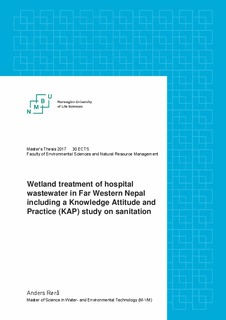| dc.description.abstract | Decentralized wastewater treatment systems are a technological approach to sanitation that often is easy to operate, cheap to construct and require little maintenance. Combining this with ecological sanitation which consider human waste as a resource and not something that needs to be disposed of is essential to provide sustainable sanitation solutions and reduce the number of people without access to improved sanitation. These systems are especially suited for rural and semi-urban areas in developing countries where centralized conventional system are absent and too expensive to build and operate. The decentralized wastewater treatment system studied in this thesis is a newly built system at Geta Eye Hospital that consist of pretreatment in an existing septic tank, biofilter and a subsurface horizontal flow constructed wetland. Final construction of the system was observed and some constructional errors are presented, with high loading rate and potential clogging of the system as the major issues. Performance evaluation of the treatment system was conducted by taking wastewater samples at strategic points and see how different parameters reduced throughout the system. The treatment efficiency of the system is based on analyses of Chemical Oxygen Demand (COD), Total Phosphorus (TP), Total Nitrogen (TN) and Total Solids (TS). The treatment efficiency of this newly constructed, immature, system is rather poor compared to more mature systems operating in Nepal, but will most likely improve as the system matures. The new treatment system at Geta Eye Hospital shows their willingness to improve their sanitation situation, but there is still need for further improvement. The improvements should be sustainable and ecological, and can include sludge drying beds, biogas reactors, urine diverting toilets as well as some technical issues. These new interventions not only improve the environmental conditions at the hospital, but might also work as a showcase for the local community to observe and learn from. Therefore, a Knowledge, Attitude and Practice (KAP) survey was conducted among households in Bijaura village, adjacent to Geta Eye
Hospital, to map the baseline sanitation situation there and see how the interventions at the hospital can benefit the local community. No one in the village knew of anyone that practiced open defecation. The households have a good knowledge about and attitude towards the value and reuse of excreta and urine as fertilizer. Over half of the households use biogas reactors that produces gas for cooking. Knowledge about safe use of sludge in agriculture is lacking for many of the households as they do not store the sludge long enough before application. | nb_NO |

